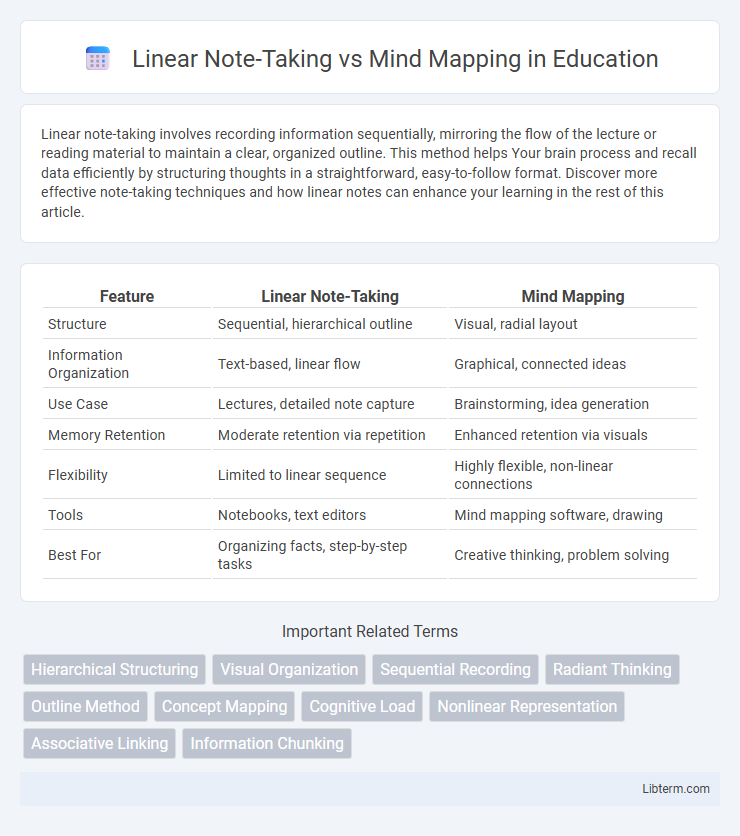Linear note-taking involves recording information sequentially, mirroring the flow of the lecture or reading material to maintain a clear, organized outline. This method helps Your brain process and recall data efficiently by structuring thoughts in a straightforward, easy-to-follow format. Discover more effective note-taking techniques and how linear notes can enhance your learning in the rest of this article.
Table of Comparison
| Feature | Linear Note-Taking | Mind Mapping |
|---|---|---|
| Structure | Sequential, hierarchical outline | Visual, radial layout |
| Information Organization | Text-based, linear flow | Graphical, connected ideas |
| Use Case | Lectures, detailed note capture | Brainstorming, idea generation |
| Memory Retention | Moderate retention via repetition | Enhanced retention via visuals |
| Flexibility | Limited to linear sequence | Highly flexible, non-linear connections |
| Tools | Notebooks, text editors | Mind mapping software, drawing |
| Best For | Organizing facts, step-by-step tasks | Creative thinking, problem solving |
Introduction to Linear Note-Taking and Mind Mapping
Linear note-taking organizes information sequentially, using bullet points or numbered lists to capture ideas in a structured, straightforward manner. Mind mapping visually represents concepts, connecting related ideas through branches radiating from a central topic, enhancing creativity and memory retention. Both methods serve distinct learning styles, with linear note-taking favoring clarity and order, while mind mapping supports holistic understanding and idea generation.
Understanding Linear Note-Taking
Linear note-taking involves recording information in a sequential, organized manner, typically using headings, bullet points, and numbered lists to capture key details and concepts. This method enhances comprehension by maintaining a clear, logical flow that reflects the structure of the source material, making it easier to review and recall information. Research shows that linear note-taking supports straightforward study patterns and is especially effective for subjects requiring detailed, step-by-step information retention.
Exploring the Mind Mapping Technique
Mind mapping enhances cognitive processing by visually organizing ideas around a central concept, promoting better memory retention and creativity compared to linear note-taking. The technique leverages colors, images, and spatial arrangement to represent relationships, enabling more effective brainstorming and problem-solving. This holistic approach accommodates nonlinear thinking, making mind maps ideal for complex information synthesis and idea generation.
Key Differences Between Linear Note-Taking and Mind Mapping
Linear note-taking structures information sequentially, making it ideal for recording detailed, step-by-step content such as lectures or reading notes. Mind mapping visually organizes concepts around a central idea, enhancing creativity and showing relationships between topics through branches and keywords. The key difference lies in linear notes' emphasis on order and completeness versus mind maps' focus on hierarchical connections and brainstorming.
Cognitive Benefits of Linear Note-Taking
Linear note-taking enhances cognitive processing by promoting structured organization and sequential information flow, which supports better comprehension and recall. This method enables learners to focus on hierarchical relationships and clear progression of ideas, aiding memory consolidation. Studies indicate that linear notes reduce cognitive load, allowing for more efficient encoding and retrieval of information during study sessions.
Creative Advantages of Mind Mapping
Mind mapping enhances creative thinking by visually organizing ideas, enabling the brain to identify relationships and generate innovative connections more effectively than linear note-taking. This method leverages spatial memory and associative thinking, encouraging divergent thought processes that stimulate problem-solving and idea expansion. By using colors, images, and branches, mind mapping engages multiple cognitive pathways, fostering deeper understanding and more dynamic brainstorming sessions.
Best Use Cases for Linear Note-Taking
Linear note-taking excels in situations requiring sequential information capture, such as lectures, meetings, or step-by-step instructions. This method is ideal for organizing detailed content chronologically, enabling easy review and clear referencing of facts or events. It suits users who prefer structured, linear outlines for thorough documentation and straightforward study.
Ideal Scenarios for Mind Mapping
Mind mapping excels in scenarios requiring creative brainstorming, complex problem solving, and visual organization of interconnected ideas. It is ideal for project planning, studying subjects with multiple subtopics, and capturing relationships between concepts. Mind maps enhance memory retention and foster innovative thinking by leveraging spatial arrangement and visual cues.
Tips for Choosing the Right Note-Taking Method
Selecting the ideal note-taking method depends on your cognitive style and the complexity of the material; linear note-taking suits sequential thinkers and straightforward information, while mind mapping benefits visual learners and complex, interconnected topics. Evaluate the purpose of your notes--use linear notes for lectures or readings requiring detailed, organized points and mind maps for brainstorming, problem-solving, or understanding relationships between concepts. Experiment with both methods to identify which enhances your retention and productivity, considering tools like digital apps that support each style for flexible, efficient note management.
Conclusion: Selecting the Optimal Note-Taking Strategy
Choosing between linear note-taking and mind mapping depends on the nature of the information and individual cognitive preferences. Linear note-taking offers a structured, sequential approach ideal for detailed lecture notes or textual content, while mind mapping enhances creativity and visual learning by connecting ideas spatially. Optimal note-taking maximizes comprehension, retention, and application by aligning the method with the user's learning style and the complexity of the subject matter.
Linear Note-Taking Infographic

 libterm.com
libterm.com